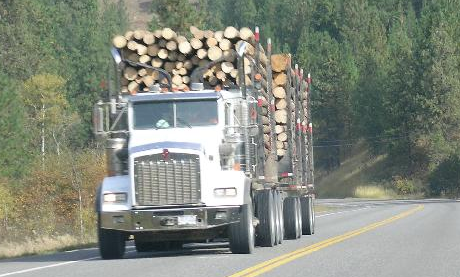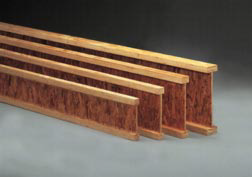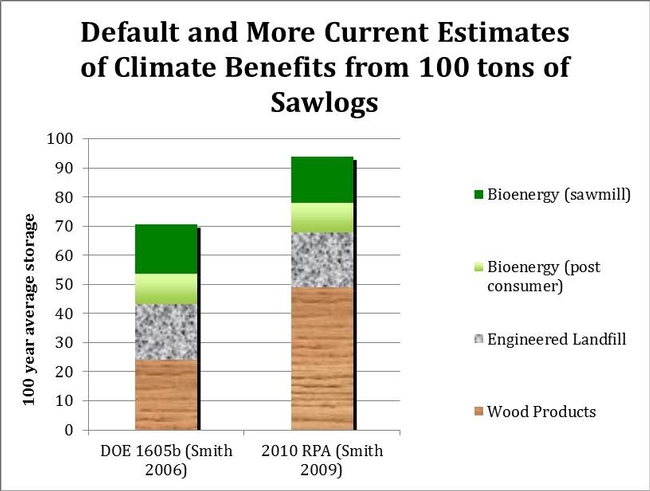
Making estimates of the life cycle benefits of harvested sawlogs are now required as part of every timber harvest plan in California. While forest managers are intimately familiar with what happens in the forest and at the landing, we are dependent on others to synthesize current and historical data to come up with accurate estimates of the ‘carbon footprint’ of sawlogs after they have left our control. Unfortunately, a number of the common calculators used in California to estimate the life cycle benefits from sawlogs depend on historic and poorly documented estimates that significantly undercount the climate benefits of harvested products. This post highlights some noticeable differences between accounting systems and concludes that data-based estimates will clarify the often underestimated benefits of wood products with respect to global carbon storage impacts.
As anyone who has seen new wood buildings going up, there are many technological innovations, such as the I-Joists (shown below), that suggests that ever more building performance is being squeezed out of logs. A key question for any accounting system that is predicting future trends is how technological innovation is addressed in the estimates.

Both the Climate Action Reserve (CAR) Forest Protocol 3.2 (http://www.climateactionreserve.org/how/protocols/adopted/forest/current/) and the Calfire GHG Estimator (http://www.fire.ca.gov/resource_mgt/resource_mgt_forestpractice_pubsmemos_memos.php) refer to a USDA Forest Service document, GTR-NE-343 (Smith 2006) or the DOE 1605b publications with the same data tables as the key source for their estimates. For simplicity, I will compare estimates based on current efficiencies with the California relevant data tables in Smith (2006). The following bar chart compares the estimated climate benefits from an initial delivery of 100 tons of sawlogs to a sawmill in California through all the end uses over a century.

The bioenergy benefits estimates for the 2006 and 2009 USDA Forest Service publications are fairly similar but are ignored by both Climate Action Reserve (CAR) and Calfire. For whatever reason, CAR and Calfire treat bioenergy from wood residues as if they create no useful energy. However, the use of wood residues for energy is considered to be a climate benefit by both the California Energy Commission and in the national accounting that the US EPA provides to the International Program on Climate Change (IPCC) since they replace fossil fuel based sources of energy.
The other differences are how much wood gets wasted in the sawmill (an estimated 15.6% in Smith 2006 versus a measured 1.5% in the 2010 RPA document), the useful life span of the wood products, the efficiency of the collection of wood waste after consumers toss it out, and whether the landfill storage gets counted as carbon storage or not. We do not need to go into great detail here, but more recent data such as Skog (2008), Smith (2009), and US EPA (2011) all provide estimates that wood carbon is stored much longer in both products and landfills than estimated by Smith (2006). The difference between more recent and better documented life cycle analyses and the CAR and Calfire protocols are even greater since CAR and Calfire ignore bioenergy.
After all the numbers are in, it appears that the best practices for utilizing sawlogs in California can retain over 90% of the initial carbon storage benefits. Unfortunately, project level accounting systems that choose to use poorly documented historic estimates and ignore bioenergy (even though bioenergy meets the Renewable Portfolio Standard –RPS - in California) come up with much lower numbers that are out of sync with more recent work in North America and Europe. For example, accounting systems that only include the carbon in wood products assumes a carbon storage efficiency of only 25%. As I mentioned earlier, any consideration of technological innovation will further improve the amount of initial wood carbon that stays in storage or is used as bioenergy.
As California moves towards our stated goals to become more energy-efficient, reduce fossil fuel related emissions, and shift away from energy-intensive building materials, we will need to ‘double check’ our math when it comes to thinking about sawlogs once they leave the landing.
References
Skog, Kenneth E. 2008 Sequestration of carbon in harvested wood products for the United States. Forest Products Journal 58 (6):56-72.
Smith, James E., Linda S. Heath, Kenneth E. Skog, and Richard A. Birdsey. 2006. Methods for calculating forest ecosystem and harvested carbon with standard estimates for forest types of the United States GTR-NE-343. USDA Forest Service, Northeastern Research Station: Newtown Square, PA.
Smith, W. Brad, tech. coord; Miles, Patrick D., data coord.; Perry Charles H., map coord,; Pugh, Scott A. Data CD coord. GTR-WO-78. 2009. Forest Resources of the United States, 2007. Washington, DC: USDA Forest Service, Washington Office.
U.S. Environmental Protection Agency. 2011. Inventory of U. S. Greenhouse Gas Emissions and Sinks: 1990 – 2008. http://epa.gov/climatechange/emissions/usinventoryreport.html